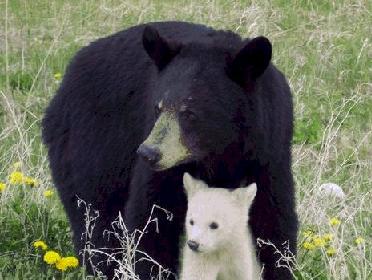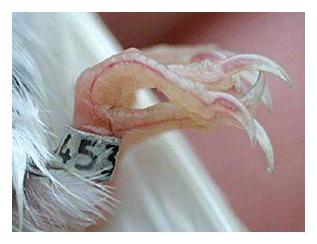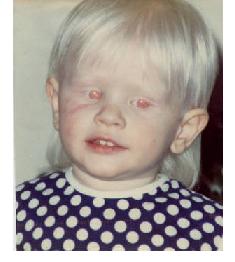
Albino Animals - Introduction
by Grandpa Cliff Jan 29, 2006

Black bear with a partially albino cub [S]
Animals that are albinos may be quite interesting to look at because they look so different from the usual color of that species. An albino may be a prized possession at a zoo or in your home aquarium. But, in nature, albinos have definite disadvantages and may not live long.
Disadvantages of Being an Albino in the Wild
1) Albinos are easier to see, and therefore they are easier for a predator to catch. Animals usually have a protective coloration that allows them to hide by blending in with their surroundings. A white animal would stand out in a forest, field, or lake, and it would become another animal's food before too long.
2) If the albino is a meat-eating predator, its prey could more easily see it coming and evade being captured. Albino predators don't get as much to eat as their normally-colored relatives. They often would become malnourished or die of starvation.
3) In most animal species, albinos look abnormal and are often rejected by others of the same species. It may be picked on until it dies or until it leaves the group to live alone. In the wild, an albino is much less likely to find a mate and have offspring. Male animals tend to be more colorful than females of the same kind. The male often uses his coloration to attract a female. Lacking the necessary coloration, albino males cannot beat out the competition.
What is Albinism?
The National Cancer Institute, a division of the U.S. National Institutes of Health, defines albinism as
"A group of genetic conditions marked by little or none of the pigment melanin in the skin, hair, and/or eyes. People with albinism may have vision problems and white or yellow hair; reddish, violet, blue or brown eyes; and pale skin."
Melanin is a dark pigment found in the skin, hair and eyes of humans and other animals. At least in humans, it is also in some internal organs. Dark colored humans and other animals have more melanin in their skin an outer covering (hair, feathers, scales). Melanin comes in two types; red to yellow (example, American Indians and Asians), and dark brown to black (example, Africans). Melanin production is genetic, meaning that it is a feature inherited from the parents of the individual. A reduced or complete lack of melanin production forms individuals we call albinos. There are about ten forms of albinism, some that don't look like what we commonly think of as albinos.
Caucasian humans, although naturally light-skinned, do have some melanin in their skin. Even more melanin is made when their skin is exposed to the ultraviolet rays of the sun (as a protection against those rays). The darkening of the skin is called tanning. Human albinos sometimes have a total lack of melanin, meaning that they will be even lighter-skinned than normal Caucasians. Since these albinos cannot make melanin, they cannot tan, and just being out in the sun can be dangerous to their health.
What do Albinos look like?

In animals (including humans), the lack of melanin can produce an individual with white skin, near-white covering (hair, feathers, scales), and pink irises of the eye.
The feet and legs of birds that normally have a dark color will look pink, because we are now able to see the blood vessels through the flesh, as shown in the photo at the right [S]. Notice the white toenails with blood vessels in only the inner part. There are many smaller vessels not visible in the photo, but they all help produce a pink-colored flesh when seen from farther away.

The albinos in the previous two paragraphs are extreme examples, and are sometimes called full albinos. With most albinos, despite inheriting genes that cause a reduced melanin production, some is still made. Most human albinos actually have blue eyes. Some have pink, or hazel or brown eyes.
Most human albinos have vision problems. Many are legally blind, although they tend to be able to read rather than use braille. In some, the vision is even good enough to qualify for a driver's license. The vision problems are due to the development of the retina in the back of the eye being abnormal. Also, the nerve connections between the eye and the brain are not the same as in people with normal vision.
According to NOAH (National Organization for Albinism and Hypopigmentation), the main test for albinism in humans is an eye test. If vision is normal, a person is not likely to have the condition.
NOAH says, " For nearly all types of albinism both parents must carry an albinism gene to have a child with albinism. Because the body has two sets of genes, a person may have normal pigmentation but carry the albinism gene. If a person has one gene for normal pigmentation and one gene for albinism, he or she will have enough genetic information to make normal pigment. The albinism gene is "recessive" — it does not result in albinism unless a person has two copies of the gene for albinism and no copy of the gene that makes normal pigment.
When both parents carry the gene, and neither parent has albinism, there
is a one in four chance at each pregnancy that the baby will be born with
albinism."
_________________________________________________________________
There are 7 webpages about albinos on Grandpa Cliff's Science Website for Teenagers.
Introduction - (this webpage) gives facts about albinos, and contains a list of all photos of albinos on this website
A List of All Photos of Albino Animals on this Website follows.
Mammals (part 1)
Human (3)
Gorilla (2)
Deer (2)
Moose (2)
Horse
Zebra
Bison (2)
Cow
Mammals (part 2)
Bear
Dingo
Cat
Lion (2)
Tiger (2)
Shrew
Rat
Mouse
Squirrel
Chipmunk
Prairie Dog
Beaver
Porcupine
Mammals (part 3)
Rabbit
Skunk
Raccoon
Ferret
Bat
Hedgehog (2)
Koala
Kangaroo
Wallaby
Whale
Dolphin
Birds
Budgerigar (Budgie, Parakeet) (2)
Northern Cardinal
Dove
Ruby-throated Hummingbird (4)
Lovebird
Owl (2)
Peacock (2)
African Penguin
American Robin
Sparrow?
Fish
Stingray
Catfish (3)
Trout
Shark, Red-tailed (aquarium)
Reptiles
Alligator
Tortoise
Snake (3)
Amphibians
Frog (3)
Salamander (2)
Invertebrates
Crabs (2)
Lobster
Slug
__________________________________________________________________
All photos and diagrams that appear on this webpage are used for educational, non-commercial purposes as allowed by the Fair Use doctrine. [S] is a link to the source of the image.
Visitors since 30
Dec 2006
Go to the HOME page
Albany, NY